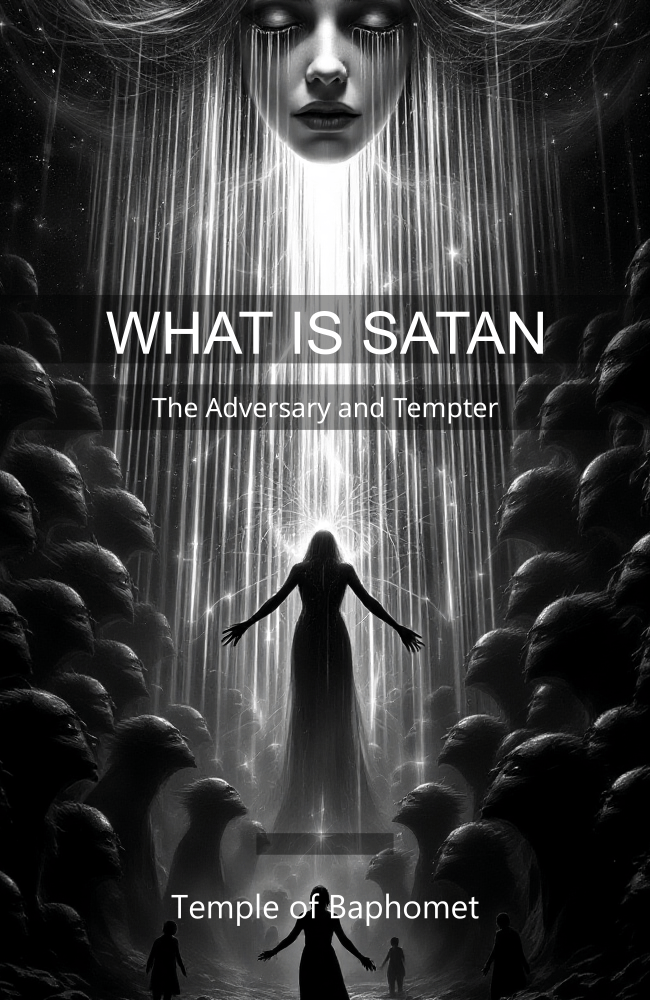What is Satan?
UNVEILING THE ADVERSARY
From whispers of rebellion to shouts of condemnation, the name Satan evokes the ultimate antagonist. He is the serpent in the garden, the lord of hellfire, the embodiment of our deepest fears. But who, or what, is he truly? Is he a person, a force, or a concept we created to embody our own darkness? The journey to an answer begins with correcting one of pop culture's biggest misconceptions: the confusion between Satan and Baphomet. While often used interchangeably, these two figures hail from completely different worlds and represent opposing ideas. Understanding their distinction is key to deciphering centuries of religion, fear, and philosophy.
Within Abrahamic traditions—Judaism, Christianity, and Islam—Satan is not a god of evil. His name literally means "adversary" or "accuser." He is a fallen angel, a tempter whose identity is fundamentally defined by his opposition to a singular God. He represents sin, pride, and the rejection of divine grace. Satan is a theological character of rebellion, a prisoner in hell rather than its proud ruler. His existence is built on dualism: an eternal, cosmic war between good and evil where you must choose a side.
In stark contrast, Baphomet is not a devil. Its most famous form was crafted in the 19th century by occultist Eliphaz Levi as a symbolic construct, a glyph containing complex ideas. Baphomet represents the reconciliation of opposites: male and female, human and animal, good and evil. The torch between its horns symbolizes enlightenment; its arms point to opposing lunar cycles. It is a symbol of esoteric knowledge and cosmic equilibrium, not malice.
The confusion is largely historical slander. During the Knights Templar trials, "Baphomet" was a false idol accusation. Centuries later, when Levi revived the name for his symbol of balance, the Church and pop culture saw a horned figure and linked it to their existing fear of Satan.
The ultimate difference lies in their core meaning. Satan represents eternal conflict. Baphomet represents sacred synthesis, asking us to integrate our light and shadow selves. One is an adversary to God; the other is a diagram of the universe. By separating them, we move from a place of fear to a place of understanding, exploring the profound power of symbols to shape what we believe.
NOTES TO REMEMBER
SATAN
Origin: Abrahamic traditions (Judaism, Christianity, Islam).
Meaning: His name literally means "adversary," "accuser," or "prosecutor."
Role: A specific entity, often a fallen angel, who rebels against God.
Identity: Defined by opposition to the divine; a cosmic rebel, not a rival god.
Concept: Embodies dualism—an eternal cosmic war between good and evil.
BAPHOMET
Origin: Not biblical; its famous form was created by 19th-century occultist Eliphas Levi.
Nature: A symbolic construct or glyph, not a deity or person to be worshipped.
Purpose: Designed to represent the reconciliation of opposites (e.g., male/female, good/evil, human/animal).
Symbolism:
Torch between horns = Enlightenment.
Arms pointing up and down = Opposing forces/lunar cycles.
Caduceus-like staff = Generative energy.
Concept: Represents synthesis, balance, and esoteric knowledge.
WHY THE CONFUSION?
Historical Slander: The name "Baphomet" was first used in the false accusations against the Knights Templar.
Visual Similarity: Later, the Church and pop culture saw Levi's horned, goat-like figure and linked it to their pre-existing concept of the devil.
Modern Panic: The "Satanic Panic" of the 1980s/90s cemented this error, using Baphomet's image to represent Satanic worship.

FREE MINI E-BOOK
Are you ready to see beyond the hype and uncover the truth behind history's most misunderstood icons?

This isn't a call to worship; it's a call to understanding. "Unveiling the Adversary" equips you with the knowledge to separate theological fact from philosophical symbol, moving from a place of fear to a place of clarity. In a world where pop culture constantly blurs the lines between myth and reality, two figures stand out as the ultimate symbols of darkness. But what if everything you thought you knew was wrong? Dive deep into the origins of Satan, the biblical rebel whose name means "adversary" in Abrahamic traditions.
Explore his role as a fallen angel, a tempter who embodies sin, pride, and opposition to divine order—not a god of evil, but a cosmic prisoner in eternal conflict. Then, uncover Baphomet, the 19th-century occult symbol crafted by Éliphas Lévi, representing the reconciliation of opposites: male and female, good and evil, light and dark. Far from a devilish idol, it's a glyph of esoteric wisdom, enlightenment, and generative energy, pointing to lunar cycles and universal balance. This concise and illuminating mini-book cuts through centuries of confusion to deliver a clear, fascinating guide.
WHAT IS INSIDE?
The Original Adversary: Unpack the true meaning of Satan as the "prosecutor" of Abrahamic faiths—a fallen angel defined by rebellion, not a ruler of Hell.
The Symbol of Balance: Decode the enigmatic Baphomet, a 19th-century emblem of enlightenment designed to unite opposites, not to be worshipped.
The Great Confusion: Learn how historical slander and modern "Satanic Panic" fused two distinct concepts into a single, terrifying pop-culture villain.
The Core Dichotomy: Understand the fundamental difference between Satan's eternal conflict (good vs. evil) and Baphomet's sacred synthesis (balancing light and shadow).
Perfect for curious minds, writers, and anyone interested in the shadows of religion and occult symbolism.
Don't just accept the myth. Uncover the meaning. Get your copy now.
Recommended References for this Lecture

E-Books
Tree of Life (E-Book)

Online Videos
Introduction to Kabbalah (FREE)
QUICK LINKS
Copyright © Temple of Baphomet



